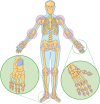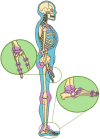Spinal posture assessment and low back pain
- PMID: 37655847
- PMCID: PMC10548303
- DOI: 10.1530/EOR-23-0025
Spinal posture assessment and low back pain
Abstract
Postural assessment can help doctors and therapists identify risk factors for low back pain and determine appropriate follow-up treatment. Postural alignment is not perfectly symmetrical, and small asymmetries can instead represent norms and criteria for postural evaluation. It is necessary to comprehensively observe patients' posture in all directions and analyze the factors related to posture evaluation. The results of reliability show that in general intra-rater reliability is higher than inter-rater reliability, and inclinometers are being more reliable than other instrumentations. Some common postural problems can cause lumbar discomfort, and prolonged poor posture is a potential risk factor for lumbar spine injuries. On the basis of previous studies on posture evaluation, a unified standardized method for posture evaluation must be established in future research.
Keywords: low back pain; posture assessment; reliability; spinal posture.
Conflict of interest statement
The authors declare that there is no conflict of interest that could be perceived as prejudicing the impartiality of the research reported.
Figures
References
-
- Sadler SG Spink MJ Ho A De Jonge XJ & Chuter VH. Restriction in lateral bending range of motion, lumbar lordosis, and hamstring flexibility predicts the development of low back pain: a systematic review of prospective cohort studies. BMC Musculoskeletal Disorders 201718179. (10.1186/s12891-017-1534-0) - DOI - PMC - PubMed
Publication types
LinkOut - more resources
Full Text Sources










